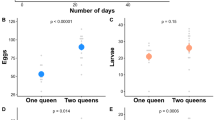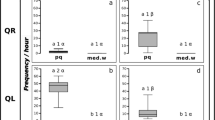Summary
Ant queens often cooperate in starting colonies (pleometrosis), but not all foundresses are likely to achieve equal reproductive success. Therefore, joining decisions may be influenced by queens' perceptions of a partner's likelihood to be of mutualistic benefit or to be a successful competitor in eventually controlling reproduction. Large queen size (as measured by weight) was assumed to be a desired characteristic in a mutualistic partner, but to be avoided in a potential competitor. With respect to this variable,Lasius pallitarsis queens appeared to join others in a manner consistent with increasing their competitive advantage. When given a choice between joining another queen or nesting alone, only queens with a large weight advantage were significantly likely to join. When given a choice between joining either a light or a heavy queen, queens of all weights preferentially joined the lighter resident. Moreover, when queen condition was improved by feeding, changes in joining behavior were consistent with predictions of improved competitive ability. Finally, lighter queens were more likely to leave nest sites when joined by others. However, queens significantly aggregated when in high densities, which may be consistent with gaining mutualistic benefits. Pleometrosis appears to have an evolutionary dynamic between mutualistic group benefits and individual competition to monopolize those benefits.
Similar content being viewed by others
References
Bartz, S. H. and B. Hölldobler, 1982. Colony founding inMyrmecocystus mimicus Wheeler (Hymenoptera: Formicidae) and the evolution of foundress associations.Behav. Ecol. Sociobiol. 10:137–142.
Donisthorpe, H. ST J. K., 1927.British Ants: Their Life-history and Classification. 2nd ed. Routledge and Sons, Ltd., London, 359 pp.
Gaspar, C., 1965. La Monogynie chezLasius niger Linnaeus résultat d'une sélection des femelles par les jeunes ouvrières (Hymenoptera Formicidae).Bull. Agronom. Stat. Rech. Gembloux 33:218–220.
Hagen, R. H., D. R. Smith and S. W. Rissing, 1988. Genetic relatedness among cofoundresses of desert ants,Veromessor pergandei andAcromyrmex versicolor (Hymenoptera: Formicidae).Psyche 95:191–201.
Hölldobler, B. and N. F. Carlin, 1985. Colony founding, queen dominance and oligogyny in the Australian meat antIridomyrmex purpureus.Behav. Ecol. Sociobiol. 18:45–58.
Mintzer, A. C., 1987. Primary polygyny in the antAtta texana: number and weight of females and colony foundation success in the laboratory.Ins. Soc. 34:108–117.
Nonacs, P., 1989. Competition and kin discrimination in colony founding by social Hymenoptera.Evol. Ecol. 3:221–235.
Nonacs, P., 1990. Size and kinship affects success of co-foundingLasius pallitarsis queens.Psyche 97:217–228.
Nonacs, P. and L. M. Dill, 1988. Foraging response of the antLasius pallitarsis to food sources with associated mortality risk.Ins. Soc. 35:293–305.
Nonacs, P. and L. M. Dill, 1990. Mortality risk vs. food quality trade-offs in a common currency: ant patch preferences.Ecology 71:1886–1892.
Reeve, H. K., 1991.Polistes. In:Social Biology of Wasps. (K. G. Ross and R. W. Matthews, Eds.), Cornell University Press, Ithaca, New York, pp. 99–148.
Rissing, S. W. and G. B. Pollock, 1988. Pleometrosis and polygyny in ants. In:Interindividual Behavioral Variability in Social Insects. (R. L. Jeanne, Ed.), Westview Press, Boulder, Colorado, pp. 179–222.
Rissing, S. W., G. B. Pollock, M. R. Higgins, R. H. Hagen and D. R. Smith, 1989. Foraging specialization without relatedness or dominance among co-founding ant queens.Nature 338:420–422.
Ross, K. G., 1988. Differential reproduction in multiple-queen colonies of the fire antSolenopsis invicta (Hymenoptera: Formicidae).Behav. Ecol. Sociobiol. 23:341–355.
Sokal, R. R. and F. J. Rohlf, 1981.Biometry, 2nd ed. W. H. Freeman, San Francisco, California, 859 pp.
Talbot, M., 1965. Populations of ants in a low field.Ins. Soc. 12:19–48.
Tschinkel, W. R. and D. F. Howard, 1983. Colony founding by pleometrosis in the fire ant,Solenopsis invicta.Behav. Ecol. Sociobiol. 12:103–113.
Waloff, N., 1957. The effect of the number of queens of the antLasius flavus (Fab.) (Hym., Formicidae) on their survival and on the rate of development of the first brood,Ins. Soc. 4:391–408.
Author information
Authors and Affiliations
Rights and permissions
About this article
Cite this article
Nonacs, P. Queen condition and alate density affect pleometrosis in the antLasius pallitarsis . Ins. Soc 39, 3–13 (1992). https://doi.org/10.1007/BF01240527
Received:
Revised:
Accepted:
Issue Date:
DOI: https://doi.org/10.1007/BF01240527




